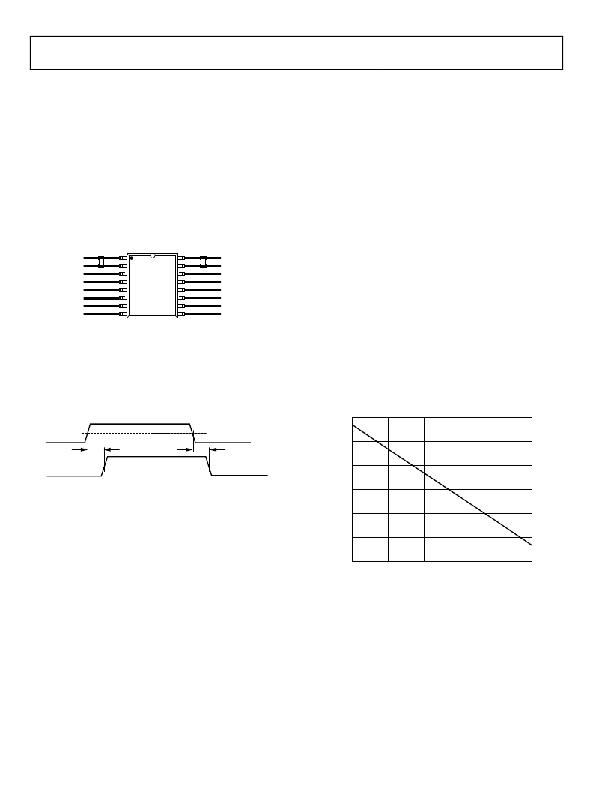- 您现在的位置:买卖IC网 > Sheet目录308 > ADUM7510BRQZ (Analog Devices Inc)IC DGTL ISOLATOR 5CH 16QSOP
�� ��
��
 ��
��ADuM7510�
�APPLICATIONS� INFORMATION�
�PRINTED� CIRCUIT� BOARD� (PCB)� LAYOUT�
�The� ADuM7510� digital� isolator� requires� no� external� interface�
�circuitry� for� the� logic� interfaces.� Power� supply� bypassing� is� strongly�
�recommended� at� the� input� and� output� supply� pins� (see� Figure� 9).�
�Bypass� capacitors� are� most� conveniently� connected� between� Pin� 1�
�and� Pin� 2� for� V� DD1� and� between� Pin� 15� and� Pin� 16� for� V� DD2� .� The�
�capacitor� value� should� be� between� 0.01� μF� and� 0.1� μF.� The� total�
�lead� length� between� both� ends� of� the� capacitor� and� the� input�
�power� supply� pin� should� not� exceed� 10� mm.� Bypassing� between�
�Pin� 1� and� Pin� 8� and� between� Pin� 9� and� Pin� 16� should� also� be�
�considered� unless� the� ground� pair� on� each� package� side� is�
�connected� close� to� the� package.�
�Data� Sheet�
�If� the� decoder� receives� no� pulses� for� more� than� about� 5� μs,� the�
�input� side� is� assumed� to� be� unpowered� or� nonfunctional,� in� which�
�case,� the� isolator� output� is� forced� to� a� default� low� state� by� the�
�watchdog� timer� circuit� (see� Table� 8).�
�The� limitation� on� the� magnetic� field� immunity� of� the� device� is�
�set� by� the� condition� in� which� induced� voltage� in� the� transformer�
�receiving� coil� is� sufficiently� large� to� either� falsely� set� or� reset� the�
�decoder.� The� following� analysis� defines� such� conditions.� The�
�ADuM7510� is� examined� in� a� 4.5� V� operating� condition� because� it�
�represents� the� most� susceptible� mode� of� operation� of� this� product.�
�The� pulses� at� the� transformer� output� have� an� amplitude� greater�
�than� 1.5� V.� The� decoder� has� a� sensing� threshold� of� about� 1.0� V,�
�V� DD1�
�GND� 1�
�V� IA�
�V� DD2�
�GND� 2�
�V� OA�
�thereby� establishing� a� 0.5� V� margin� in� which� induced� voltages�
�can� be� tolerated.� The� voltage� induced� across� the� receiving� coil� is�
�V� IB�
�V� IC�
�V� ID�
�V� IE�
�GND� 1�
�ADuM7510�
�V� OB�
�V� OC�
�V� OD�
�V� OE�
�GND� 2�
�given� by�
�V� =� (?� dβ� /� dt� )∑∏� r� n� 2� ;� n� =� 1,� 2,� …,� N�
�where:�
�Figure� 9.� Recommended� PCB� Layout�
�See� the� AN-1109� Application� Note� for� board� layout� guidelines.�
�PROPAGATION� DELAY-RELATED� PARAMETERS�
�Propagation� delay� is� a� parameter� that� describes� the� length� of�
�time� it� takes� for� a� logic� signal� to� propagate� through� a� component.�
�The� propagation� delay� to� a� logic� low� output� can� differ� from� the�
�propagation� delay� to� a� logic� high� output.�
�β� is� the� magnetic� flux� density.�
�r� n� is� the� radius� of� the� n� th� turn� in� the� receiving� coil.�
�N� is� the� number� of� turns� in� the� receiving� coil.�
�Given� the� geometry� of� the� receiving� coil� in� the� ADuM7510� and�
�an� imposed� requirement� that� the� induced� voltage� be,� at� most,�
�50%� of� the� 0.5� V� margin� at� the� decoder,� a� maximum� allowable�
�magnetic� field� is� calculated,� as� shown� in� Figure� 11.�
�1000�
�INPUT� (V� Ix� )�
�t� PLH�
�t� PHL�
�50%�
�100�
�OUTPUT� (V� Ox� )�
�50%�
�Figure� 10.� Propagation� Delay� Parameters�
�10�
�1�
�Pulse� width� distortion� is� the� maximum� difference� between�
�these� two� propagation� delay� values� and� is� an� indication� of� how�
�accurately� the� input� signal� timing� is� preserved.�
�Channel-to-channel� matching� refers� to� the� maximum� amount�
�the� propagation� delay� differs� between� channels� within� a� single�
�0.1�
�0.01�
�ADuM7510� component.�
�0.001�
�1k�
�10k� 100k� 1M� 10M�
�100M�
�Propagation� delay� skew� refers� to� the� maximum� amount� the�
�propagation� delay� differs� among� multiple� ADuM7510� com-�
�ponents� operated� under� the� same� conditions.�
�DC� CORRECTNESS� AND� MAGNETIC� FIELD� IMMUNITY�
�Positive� and� negative� logic� transitions� at� the� isolator� input�
�cause� narrow� (~1� ns)� pulses� to� be� sent� via� the� transformer� to�
�the� decoder.� The� decoder� is� bistable� and� is,� therefore,� either� set�
�or� reset� by� the� pulses� indicating� input� logic� transitions.� In� the�
�absence� of� logic� transitions� at� the� input� for� more� than� ~1� μs,�
�MAGNETIC� FIELD� FREQUENCY� (Hz)�
�Figure� 11.� Maximum� Allowable� External� Magnetic� Flux� Density�
�For� example,� at� a� magnetic� field� frequency� of� 1� MHz,� the�
�maximum� allowable� magnetic� field� of� 0.5� kgauss� induces�
�a� voltage� of� 0.25� V� at� the� receiving� coil.� This� is� about� 50%� of� the�
�sensing� threshold� and� does� not� cause� a� faulty� output� transition.�
�If� such� an� event� occurs� with� the� worst-case� polarity� during� a�
�transmitted� pulse,� it� reduces� the� received� pulse� from� >1.0� V� to�
�0.75� V,� still� well� above� the� 0.5� V� sensing� threshold� of� the�
�decoder.�
�a� periodic� set� of� refresh� pulses� indicative� of� the� correct� input�
�state� are� sent� to� ensure� dc� correctness� at� the� output.�
�Rev.� B� |� Page� 8� of� 12�
�发布紧急采购,3分钟左右您将得到回复。
相关PDF资料
ADZS-21364-EZLITE
KIT EVAL EZ LITE ADDS-21364
ADZS-21371-EZLITE
KIT EVAL EZLITE ADZS-21371
ADZS-21469-EZLITE
KIT EVAL EZ LITE ADSP-21469
ADZS-21479-EZLITE
KIT EVAL EZ BOARD ADSP-2147X
ADZS-21489-EZLITE
KIT EVAL EZ BOARD ADSP-2148X
ADZS-218X-ICE-2.5V
EMULATOR SRL FOR ADDS-218X-ICE
ADZS-BF506F-EZLITE
KIT EVAL EZLITE ADSP-BF506F
ADZS-BF518F-EZLITE
KIT EZ LITE BF512F/14F/16F/18F
相关代理商/技术参数
ADUM7510BRQZ-RL7
功能描述:IC DGTL ISOLATOR 5CH 16QSOP RoHS:是 类别:隔离器 >> 数字隔离器 系列:iCoupler® 产品培训模块:IsoLoop® Isolator 标准包装:50 系列:IsoLoop® 输入 - 1 侧/2 侧:5/0 通道数:5 电源电压:3 V ~ 5.5 V 电压 - 隔离:2500Vrms 数据速率:110Mbps 传输延迟:12ns 输出类型:CMOS 封装/外壳:16-SOIC(0.154",3.90mm 宽) 供应商设备封装:16-SOIC N 包装:管件 工作温度:-40°C ~ 85°C 其它名称:390-1053-5
ADUM7510BRWZ
制造商:Analog Devices 功能描述:
ADUM7510BRWZ-RL
制造商:Analog Devices 功能描述:
ADUM7640ARQZ
功能描述:隔离器接口集成电路 1 kV Six-Channel Digital Isolators RoHS:否 制造商:Texas Instruments 通道数量:2 传播延迟时间: 电源电压-最大:5.5 V 电源电压-最小:3 V 电源电流:3.6 mA 功率耗散: 最大工作温度:+ 125 C 安装风格: 封装 / 箱体:SOIC-8 封装:Tube
ADUM7640ARQZ-RL7
功能描述:隔离器接口集成电路 1 kV Six-Channel Digital Isolators RoHS:否 制造商:Texas Instruments 通道数量:2 传播延迟时间: 电源电压-最大:5.5 V 电源电压-最小:3 V 电源电流:3.6 mA 功率耗散: 最大工作温度:+ 125 C 安装风格: 封装 / 箱体:SOIC-8 封装:Tube
ADUM7640CRQZ
功能描述:隔离器接口集成电路 1 kV Six-Channel Digital Isolators RoHS:否 制造商:Texas Instruments 通道数量:2 传播延迟时间: 电源电压-最大:5.5 V 电源电压-最小:3 V 电源电流:3.6 mA 功率耗散: 最大工作温度:+ 125 C 安装风格: 封装 / 箱体:SOIC-8 封装:Tube
ADUM7640CRQZ-RL7
功能描述:隔离器接口集成电路 1 kV Six-Channel Digital Isolators RoHS:否 制造商:Texas Instruments 通道数量:2 传播延迟时间: 电源电压-最大:5.5 V 电源电压-最小:3 V 电源电流:3.6 mA 功率耗散: 最大工作温度:+ 125 C 安装风格: 封装 / 箱体:SOIC-8 封装:Tube
ADUM7641ARQZ
功能描述:隔离器接口集成电路 1 kV Six-Channel Digital Isolators RoHS:否 制造商:Texas Instruments 通道数量:2 传播延迟时间: 电源电压-最大:5.5 V 电源电压-最小:3 V 电源电流:3.6 mA 功率耗散: 最大工作温度:+ 125 C 安装风格: 封装 / 箱体:SOIC-8 封装:Tube